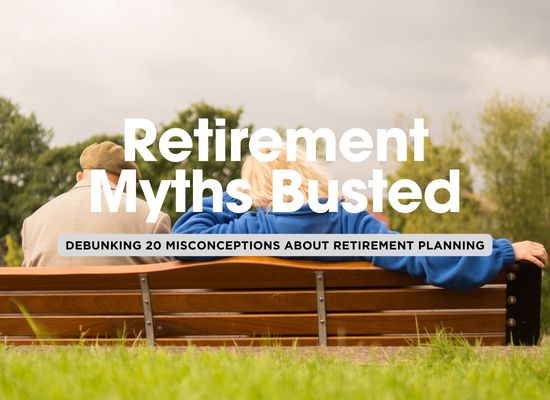Retirement planning is an essential step in securing a comfortable future, but it’s often clouded by myths and misconceptions. Many people believe certain strategies or advice without fully understanding their implications, leading to poor decisions that can jeopardize long-term financial security. In this article, we will break down the top 20 myths surrounding retirement building, offering clarity and practical insights to help you plan more effectively for your golden years.
1. You’ll Need 80% of Your Pre-Retirement Income 💰💡
Many financial experts suggest that you’ll need to replace about 80% of your pre-retirement income to maintain your lifestyle in retirement.
- Why it’s a myth: While this might apply to some people, your actual needs will vary based on your lifestyle, health, and spending habits. For example, if you’re debt-free, don’t have mortgage payments, and are no longer saving for retirement, you may need less.
- The truth: It’s essential to evaluate your own needs and adjust your retirement savings strategy accordingly. Make a detailed budget of expected expenses post-retirement to get a more accurate figure.
2. The Earlier You Start Saving, the More You’ll Need to Save 🕰️📊
There’s a widespread belief that the earlier you begin saving for retirement, the more you will need to contribute to reach your goal.
- Why it’s a myth: While it’s true that starting early gives you more time to accumulate wealth, it doesn’t necessarily mean that you have to save an overwhelming amount.
- The truth: Thanks to compound interest, saving even a small amount early on can lead to significant growth over time. The key is consistency, not necessarily large contributions, especially if you take advantage of tax-advantaged retirement accounts like IRAs or 401(k)s.
3. Social Security Will Be Enough to Cover Your Retirement 💼💸
Many individuals believe that Social Security benefits will provide a significant portion of their retirement income, possibly enough to live comfortably.
- Why it’s a myth: Social Security is meant to supplement retirement income, not replace it entirely. In most cases, it will only cover a fraction of your pre-retirement income.
- The truth: Relying solely on Social Security is risky. It’s important to have additional retirement savings to cover the gap. Diversify your savings with employer-sponsored plans, IRAs, and other investment vehicles to ensure financial security.
4. You’ll Spend Less in Retirement 🏠💭
Many people assume that their spending will automatically decrease in retirement, as they won’t have work-related expenses and will have more free time.
- Why it’s a myth: While some expenses, like commuting costs or work attire, may decrease, other costs often rise in retirement. Healthcare, travel, and hobbies can lead to higher expenses.
- The truth: Consider that healthcare costs may increase as you age, and if you plan to travel more or pursue costly hobbies, your expenses could rise. It’s essential to account for these potential increases in your retirement budget.
5. You Can Rely on Your Home’s Value for Retirement Income 🏡💵
Some people believe that they can sell their home and use the proceeds to fund their retirement.
- Why it’s a myth: While your home may have significant value, it may not be as reliable a source of retirement income as you think. The housing market can fluctuate, and selling your home might not provide as much money as anticipated, especially when you factor in moving costs and potential tax implications.
- The truth: It’s better to plan for retirement savings from various sources, including investments, pensions, and savings accounts, rather than relying on the sale of your home.
6. You Can’t Access Your Retirement Funds Until You’re 59½ 🏦🔓
Many people believe they must wait until they reach 59½ to access funds from their retirement accounts without penalties.
- Why it’s a myth: While it’s true that retirement accounts like 401(k)s and IRAs impose penalties for early withdrawals before age 59½, there are exceptions.
- The truth: You can access funds earlier in certain cases, such as using a 401(k) loan, hardship withdrawals, or utilizing specific programs like SEPP (Substantially Equal Periodic Payments). It’s important to understand the rules around your specific retirement plan to avoid unnecessary penalties.
7. Retirees Don’t Need Life Insurance 🚫💼
Once you retire, many believe that life insurance is no longer necessary, especially if you no longer have dependents or a mortgage.
- Why it’s a myth: While your needs may change in retirement, life insurance can still be important for covering final expenses, leaving a legacy, or protecting your spouse if they rely on your assets.
- The truth: Consider a smaller life insurance policy or a whole life plan that can also serve as an investment for your heirs. It’s worth evaluating whether life insurance still fits into your post-retirement financial strategy.
8. Your Employer’s 401(k) Will Be Enough for Retirement 💼💵
Some people assume that contributing to their employer’s 401(k) plan will be enough to provide for a comfortable retirement.
- Why it’s a myth: While 401(k)s are a great tool for retirement savings, they are typically not enough on their own.
- The truth: Employers may not provide enough matching contributions, and investment options within the 401(k) plan can sometimes be limited. It’s important to supplement your 401(k) savings with other retirement accounts, such as an IRA or taxable investment accounts, to ensure you have enough for retirement.
9. You Can Stop Saving for Retirement Once You Hit Your Target Amount 🎯💸
Many people believe that once they’ve saved a certain amount for retirement, they can stop contributing and live off their savings.
- Why it’s a myth: Inflation, unexpected expenses, and increasing life expectancy mean that your savings need to continue growing throughout retirement.
- The truth: Even in retirement, you should keep your savings invested and growing, ideally through a diversified portfolio. Planning to draw down your savings over time requires careful management to avoid outliving your funds.
10. It’s Too Late to Start Saving for Retirement ⏳💡
A common myth is that if you haven’t started saving for retirement by your 30s or 40s, it’s too late to build a secure retirement fund.
- Why it’s a myth: It’s never too late to start saving. While starting early certainly has its advantages, contributing to your retirement savings at any age can still make a significant impact.
- The truth: Even if you’re behind on retirement savings, you can catch up by making larger contributions, focusing on tax-advantaged accounts, and adopting a more aggressive investment strategy. There are also “catch-up” contribution options for those over 50 to help boost savings in later years.
11. You Don’t Need to Plan for Healthcare Costs in Retirement 🏥💸
Many people assume that Medicare or employer-sponsored health insurance will cover all healthcare expenses in retirement.
- Why it’s a myth: Medicare doesn’t cover everything. Out-of-pocket costs for things like long-term care, dental work, vision, and prescription drugs can add up significantly.
- The truth: It’s essential to plan for healthcare costs in retirement by considering supplemental health insurance, health savings accounts (HSAs), and long-term care insurance. Experts recommend setting aside funds specifically for healthcare expenses in retirement to avoid unexpected financial strain.
12. Your Retirement Savings Should Only Be Invested in Stocks 📈💼
There’s a common belief that investing exclusively in stocks is the best way to grow your retirement savings.
- Why it’s a myth: While stocks can provide strong growth potential, they also come with volatility, which may not be ideal for retirees or those nearing retirement.
- The truth: A balanced portfolio that includes bonds, real estate, and other lower-risk investments can help reduce the impact of market volatility. Diversification is key to minimizing risk while achieving steady growth over time.
13. You Can’t Retire Until You’ve Paid Off Your Mortgage 🏠💰
Many people think that retiring without paying off your mortgage is financially irresponsible.
- Why it’s a myth: While it’s ideal to be debt-free, especially for retirees, carrying a mortgage doesn’t necessarily prevent you from retiring comfortably.
- The truth: Depending on your overall financial situation, you may be able to afford to retire with a mortgage if your income from other sources (like savings, pension, or Social Security) is sufficient to cover the mortgage payments. Some retirees choose to downsize or refinance to reduce monthly expenses.
14. You Shouldn’t Withdraw Retirement Funds Until Absolutely Necessary 🏦⏳
It’s a common belief that you should only withdraw from your retirement accounts when you’re forced to or absolutely need the money.
- Why it’s a myth: Delaying withdrawals can sometimes result in missed opportunities, such as tax benefits or investments that are no longer aligned with your needs.
- The truth: Strategic withdrawals can be part of an effective retirement strategy. For example, withdrawing funds from tax-deferred accounts early in retirement, while your tax bracket is lower, can reduce future tax liabilities. It’s important to create a withdrawal strategy that aligns with your income needs and tax planning.
15. Social Security Will Be There for Everyone 💼🔒
Many people believe that Social Security will be a reliable source of income, regardless of their retirement plans.
- Why it’s a myth: While Social Security provides essential benefits, it was never designed to fully support retirees. The future of Social Security is also uncertain due to funding issues, and there may be changes to the system as the population ages.
- The truth: You should not rely solely on Social Security for retirement income. It’s critical to have additional savings through employer-sponsored plans, IRAs, or other investment vehicles to ensure financial security during retirement.
16. You Can Live Comfortably on a Fixed Income in Retirement 💸💼
There’s a belief that retirees can easily live on a fixed income, such as Social Security or pensions, and maintain a comfortable lifestyle.
- Why it’s a myth: Fixed incomes often don’t keep pace with inflation or rising healthcare costs, which can reduce purchasing power over time.
- The truth: To truly live comfortably in retirement, you’ll likely need supplemental income from savings, investments, or part-time work. A diversified retirement income strategy is key to maintaining financial flexibility and stability.
17. Retirees Can Just “Spend Down” Their Savings 💰⏳
Many people think that in retirement, they can simply “spend down” their savings over time without worrying about running out.
- Why it’s a myth: If you withdraw too much too quickly from your savings, you risk depleting your funds prematurely, especially with increasing life expectancy and inflation.
- The truth: It’s important to have a systematic withdrawal strategy in place. Using the “4% rule” or other personalized withdrawal methods can help ensure that your savings last for the duration of your retirement.
18. The Stock Market Is Too Risky for Retirement Savings 📉📈
Some people avoid investing in the stock market altogether due to the perceived risk.
- Why it’s a myth: While the stock market does come with volatility, it’s also one of the most effective ways to grow retirement savings over time, especially for younger investors.
- The truth: A diversified portfolio that includes a mix of stocks, bonds, and other assets can help mitigate risk. Staying invested in the market, even through downturns, can lead to long-term growth. It’s important to adjust your investment strategy as you approach retirement to reduce exposure to riskier assets.
19. Retirement Planning is Only About Saving Money 💵📝
Retirement planning is often focused solely on how much you save, but there’s much more to it.
- Why it’s a myth: Saving is only part of the equation. How you manage and allocate your savings, along with your spending strategy, taxes, and other financial considerations, play a major role in a successful retirement.
- The truth: Retirement planning involves tax planning, asset allocation, healthcare considerations, and other factors to ensure your wealth is well-managed and that you don’t outlive your savings. Working with a financial advisor can help you develop a comprehensive strategy.
20. You’ll Be Able to Work Part-Time in Retirement 💼👵
Some assume they can easily transition to part-time work in retirement to supplement their income.
- Why it’s a myth: While some retirees may enjoy part-time work, the availability and nature of part-time jobs may not match expectations, especially as you age. Health issues, the job market, and other factors can impact your ability to work.
- The truth: It’s best not to rely on part-time work as a guaranteed income source in retirement. Ensure you have enough savings and passive income sources to cover your living expenses without depending on employment.


